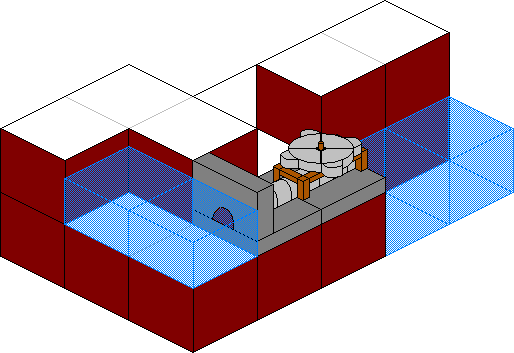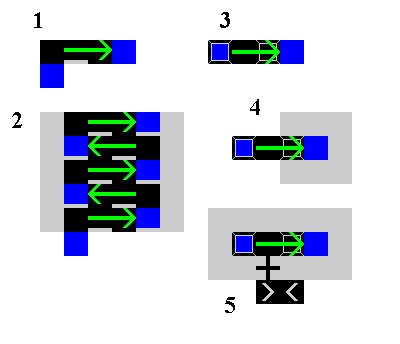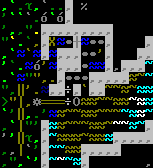- v50 information can now be added to pages in the main namespace. v0.47 information can still be found in the DF2014 namespace. See here for more details on the new versioning policy.
- Use this page to report any issues related to the migration.
40d:Screw pump
|
b-M-s | |||||||
| |||||||
| Job Requirement | |||||||
|---|---|---|---|---|---|---|---|
| Construction | |||||||
| Materials | Jobs | ||||||
| |||||||
| Power | |||||||
|
Needs 10 power. | |||||||
A screw pump is a small building that can lift liquids (water or magma) from one level below onto the same Z-level as the pump. It is two tiles by one tile in size, and it can be either manually operated by a dwarf with the pump operator job or by using gear assemblies connected to water wheels and/or windmills.
The direction you want the fluid to travel must be chosen at the time of construction. Pumping only occurs in a straight line, and involves a total of 4 tiles in a row - the liquid source, two for the pump, and the output. The "rise" in levels occurs on the first tile, the intake side, from one level below up to the level of the pump*. Pumped fluids can and will flow immediately after being pumped, as normal for that fluid. Pumped fluids will have a pressure equal to the exit z-level - a pump never "forces" water to a higher z-level than the output tile.
- (* A DF pump can best be imagined as a simple archimedes screw.)
Salt water pumped through a pump will become drinkable if then kept separate from natural walls, natural floors, other salt water or an aquifer.
Construction
Building a screw pump requires an enormous corkscrew, a block, and a pipe section. The construction itself is completed in two stages. First a dwarf with the architect labor must design it. Then a dwarf (the same or a different one) with the appropriate labor must complete the building. This could be carpentry, metalsmithing, or masonry, depending on the material of the block.
It's important to choose the proper orientation for your pump, where it will draw water from and where it will deliver the water. This is determined before placement with the u, k, m, or h keys, and the text at the top of the sub-menu will change to confirm your choice. The default (as shown above in the sidebar), "pumps from the north" (top). The light green X must be next to the liquid source and the dark green X is where the liquid exits the pump.

This pump "pumps from the west", from left to right. The area to the right may fill to the top of that level, but no more (See pressure; see Pump stack). Note that the entire space required is 4 tiles long by 1 tile wide, not including any retaining walls for the outflow.
(Altho' the "liquid" is shown as blue, this can work for magma as well, with the appropriate precautions.)
X X
This example "pumps from the west" (left) to the east (right), the h option.
The orientation is visible after placement only by using query over or near that pump. Orientation of a pump cannot be changed after being constructed, but, as with any building, it can be deconstructed into its component parts and rebuilt as and where desired.
Having specified the direction of travel, you must ensure that the source side of the pump is placed adjacent to and above (in the z-axis) a liquid. The screw pump will draw the liquid up from below its level, and distribute it out of the other side of the pump.
Notes
- The source of the pump must be directionally adjacent to "Open Space" that is directly above a source of liquid. The adjacent space cannot be a floor, stairway or wall suspended over water. Screw pumps can pump water through a grate or floor bars.
- The light pump tile is where a pump operator will stand (if the pump is not powered mechanically). Liquids to be pumped must be 1 level below the (empty) area adjacent to this tile.
- Dwarves must be able to access and stand on the light tile of the pump in order to build the pump and then to be able to operate the pump manually.
- The dark pump tile is on the output side. Liquids will appear in the tile adjacent to this.
- The dark pump tile blocks liquids flow and creature movement, and can be built into a wall to create a solid barrier. The light tile of the pump does not block flow or movement.
- Pumps can also be used in conjunction with a water wheel or a windmill to become self-powered.
- Active mechanisms connected to the pump will automatically start the pump; to prevent this either restrict liquid flow using floodgates or hatches, or put in a gear assembly linked to a lever to disconnect the power.
- Adjacent pumps automatically transfer mechanical power to any other adjacent pump(s), no axle or mechanism is required. If too many pumps are adjacent, there may be insufficient power to power them.
- A hatch above the input tile (on the same level as the pump) that is linked to a trigger (a lever or pressure plate) makes an effective on/off switch for that pump.
- In order to build pumps in a "hanging" state, as in the stacked screw pump example (below), one of its tiles must be able to connect to a nearby machine, either already existing or designated to be built. If, when the screw pump's construction is completed, the supporting mechanism has not yet been completed, it will promptly collapse into its component parts.
- Pumps do not push liquids up additional Z-levels above them. They only deliver water to their own level. That is, if you direct the output of a screw pump into a 1-square space surrounded by walls, the water will not "overflow" the walls. Consequently, a pump will refuse to move liquid if the level it is pumping to is completely filled. Higher levels can be achieved using a "pump stack" (below). (See Pressure)
- In order to safely pump magma, you do not need to build a pump out of magma-safe materials, unless the open tile is going to be submerged in magma.
Common mistakes
- Orienting a pump incorrectly, and/or not having a proper open liquid source.
- Pumping water into an area with a path to other parts of your fortress. (The pump may work perfectly - the fortress quickly floods.)
- Expecting water to rise up above the same level of a pump.
- Building a wall attached only to the light tile - this leaves a diagonal leak between the wall and the dark tile unless sealed there. (If that's not a problem, don't worry about it.)
Example layouts
Single Pump
Pumping up multiple levels
The easiest way to do this is to stack the pumps directly on top of each other in alternating directions, also known as a pump stack. The first one pumps North to South, the one directly above it pumps South to North, the next one above that pumps North to South again, ad infinitum. Even without walls surrounding the pumps, water still gets up with only minor leakage.
Adjacent pumps automatically transmit mechanical power. If the pumps are "open" (that is, built on channeled tiles) to each other across z-levels, then a stack only requires (sufficient) power to be tranferred to one pump. All others will be powered by association with the first. You can transmit power to each pump by simply channeling out the floor at the front (aka output side).
'See diagram, right This example is from a Bay12 forum thread.
- Side view of the basic pump unit. Water is moved from the lower floor to the upper; notice how the front of the pump does not need a floor.
- Side view of stacked screw pumps. Power is transmitted vertically through the missing floor tiles under the fronts of the pumps - no need for gearboxes in this design. The screw pump front prevents the water from flowing diagonally downwards.
- Top view of the entire pump stack, 4 tiles long (plus retaining walls and access, optional).
- Top view with walls in place to prevent the receiving area from spilling out. If this is all it needed, these units could be stacked on top of each other, but it's missing one thing - dwarf access. There's no stairs/ramps, and no good place to put them either that wouldn't interfere with the adjacent levels' water containment.
- Solution for a freestanding tower - fire escape! You can also consolidate the up and downstairs into a single up/down stair tile. Just build these on top of each other, flipping horizontally each time. Minimal yet aesthetic multi-level water pumping.
Running a pump with a windmill
First, build a windmill anywhere aboveground (note that it won't do anything yet).
Then, build the pump. The end you selected to 'pump from' will suck water up from the level below, then pump it out of the other end. Build with this in mind. If you want to pump from a river, the 'pump from' end should be on the river.
Both the pipe and corkscrew can be built by a carpenter, (the corkscrew is listed as something like 'enormous wooden cor' if you are using the single-width screen, but hitting Tab to expand the screen should reveal the full text).
Connecting windmills to pumps:
Note that it's much easier if the centre of the windmill lines up with the pump.
- Dig one level below the windmill and put a gear assembly directly beneath the axle (at centre of windmill). The windmill will start turning.
- You're probably going to want to bring your power up to the surface. To do this, dig away from the first gear until the surface is clear above. Place another gear here.
- Connect the gears together using a horizontal axle.
- Get a miner to channel on top of the second gear.
- Build a third gear in this channel. You should now have a turning gear on the surface.
- If you thought ahead, you should only need one axle to connect the surface gear to the pump. A pump can be powered from any side.
I recommend that you connect a lever to one of your gears beforehand. The pump will start pumping as soon as it has power.
You can change stuff around as the situation dictates, but that should get you started.
The pictures aren't lined up - the far right gear in the second picture is the one below the surface gear.
Alternative uses
Attribute gain
Pumps can also be built with no actual pumping in mind but as dwarven exercise machines. This is an excellent method to train haulers for better strength and agility or for future soldiers. (See cross-training.)
Desalinization
Screw pumps also act to desalinate any water which is pumped through them. This is very useful for providing a source of potable water in otherwise entirely salt-water regions. However, if desalinated water comes into contact with natural walls or natural floors, other saltwater, or passes through a saltwater aquifier level (even if that has been sealed by smoothing) (Unclear as to what this means), the water will be resalinated. So any freshwater cistern (tanks) must be entirely constructed to the full level of the water, with no natural floors or walls that will come in contact with the de-salinated water.
Plumbing management
Screw pumps can be used to "reset" water pressure, preventing a surface water source from flooding a fortress through a well or fishing hole.
Power transfer through walls
Screw pumps can also be built as a means of transmitting mechanical power from one side of a wall to the other without allowing creatures or liquids to pass through. Simply replace one square of the wall with the impassable square of the pump, and connect axles or gear assemblies to the pump on either side of the wall. If containing fluids, of course make sure that the pump is pumping into the submerged area, not out of it.
External links
- DFMA Ingame Videos featuring screw pumps: (Movies with Pump in the title)
- DFMA Ingame Video tutorial on How to desalt salt water




